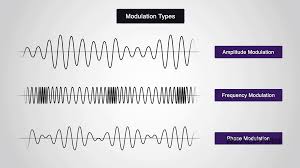Modulation
- In a broad sense, communication is the exchange of information either wired or wireless between the two points which are far away from each other. so, this information could be voice signal, or email, or even a television signal.
- If we consider the speech signal or the human voice signal then it contains the frequencies up-to 3 KHz and if we consider the entire audible spectrum then it varies from 20 Hz to 20 KHz. So, this low frequency or the message signal in known as the base-band signal.
- The base band signal cannot be transmitted directly but with the help of the high frequency periodic signal, it can transmitted. this high frequency periodic signal which carries this base-band signal is known as the carrier signal.
- Any signal has a three basic properties that is amplitude, phase and the frequency.
- The modulation is the process where one of these properties of the carrier signal like the amplitude, phase and the frequency is changed according to the base-band signal. And based on which property changed there are different types of modulation.
Different type of modulation : there are two types of modulation
a) Analog Modulation
- If the message signal is analog then then it is known as the analog modulation Based on the type of the carrier signal this analog modulation can be further classified into two categories
b) continuous wave modulation
- If the carrier signal is continuous wave signal like a sine wave signal then it is known as the continuous wave modulation. it classified in three parts-
- Amplitude modulation :- The amplitude modulation of the carrier wave changes according to the message signal. So, this is the message signal and the high-frequency is the carrier signal. The shape of the change can according to the message signal
- Frequency modulation :- In case this modulation the frequency of the carrier wave changes according to the message signal. So, with increase in the amplitude of the message signal, the frequency of the modulated signal will also increase. Similarly with the reduction in the amplitude, the frequency of the modulated signal will also reduced.
- Phase modulation :- The phase of the modulated signal changes according to the message signal.
c) Pulse modulation
- if the carrier signal is a pulse then it is known as the pulse modulation. They are mainly classified in four types i) pulse modulation ii) pulse width modulation iii) pulse position modulation iv) pulse code modulation
- In all these modulation techniques, the message signal is analog in nature while the carrier signal is a pulse train of the finite frequency. So in case of the pulse amplitude modulation, the width of the duration of the pulse will remain same,but the height or the amplitude of the pulse signal will change according o the message of the signal.
- In case of the pulse width modulation,the height of the amplitude of the pulse will remain same,but the width of the pulse will change according to the message signal.
- In case of pulse position modulation,the width and the amplitude of the pulse will remain fixed but the position of the modulated signal will change according to the input signals.
- In pulse code modulation,the message signal is sampled at the finite interval and the sampled value is quantize using the quantization process and then using the analog to digital converter,the message signal is encoded.
d) Digital Modulation
- If the message signal is digital form or in terms of 1s to 0s then it is known as digital modulation. it can be classified in three types i)Amplitude shift keying ii) Phase shift keying iii) Frequency shift keying.
- So in all these digital modulation schemes,the message signal is in digital form. In this amplitude shift keying is one form of digital amplitude modulation where the amplitude of the modulated signal changes according to the digital bit-stream.
- In case of Frequency shift keying,the frequency of the modulated signal changes according to the digital bit-stream.
- likewise the phase shift keying,the phase of the modulated signal is changes according to the digital bit-stream
-
Why the modulation is required
- the first reason to use this modulation is to reduce the antenna size. So, when the signal is transmitted wireless then the size of the antenna is a very important parameter.the size of the antenna is proportional to the wavelength of the transmitted signal and depending upon the type of the antenna, it is fraction of the transmitted wavelength.The size of the antenna is equal to ^/4.
- The second is to reduced the interference.
- To allow the multiplexing of the signals.
